Trail of Memories
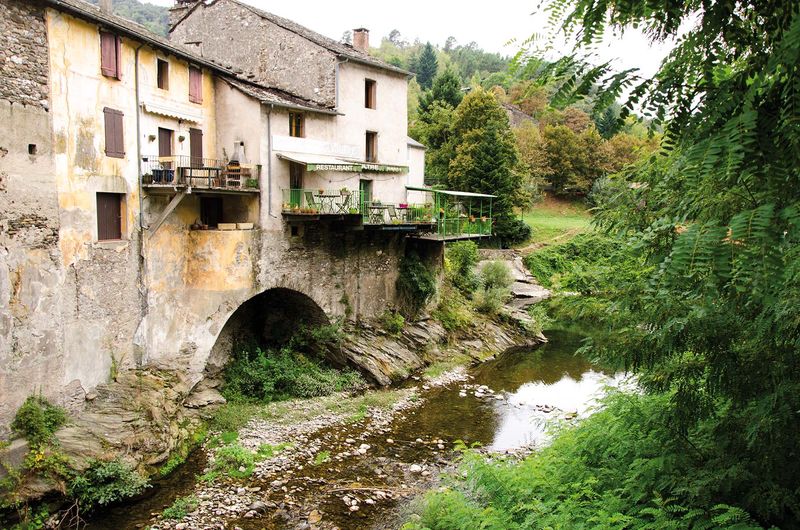
Sainte-Croix-Vallée-Française Discovery
Discovery
Trail of Memories
Very easy
1h30
2,2km
+40m
-39m
Loop
Embed this item to access it offline
In the 1930s, Sainte-Croix-Vallée-Française was a hive of activity: crafting, farming and festivities. The Gardon river reflected the houses, and set the rhythm of life. A circuit of 21 audio points lets you to explore the villagers’ daily life as told by oral history. Some 30 works by regional artists illustrate the economic activity of the time.
20 points of interest
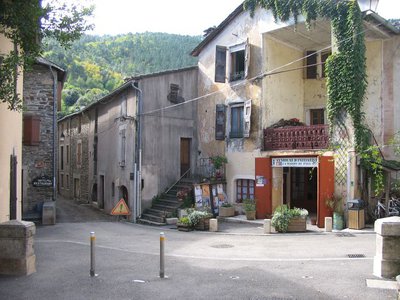
La Placette - © Mémoire vivante  History
HistoryThe little square
Marker 1
The Trail of Memories began with “Fifteen sessions of memory sifting initiated by the Mutualité sociale agricole, [after which] the participants began collecting oral history. Annie, Madeleine, Rémi told us about their Sainte-Croix of the 1930s...”
Encouraged by the town council’s trust, the group suggested a project to transmit oral history via a circuit in the village with works by 12 local artists evoking its economic and festive activities in situ. The trail was then expanded by 21 audio points of popular history, told by those who were there.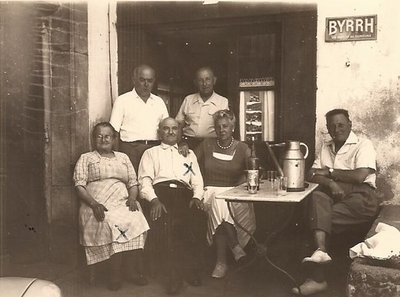
© Mémoire vivante  History
HistoryThe grocers
Marker 2
The village’s grocers depended on distribution chains which had begun to develop in France in the late 19th century.
Economats du Centre and La Ruche had branches in Montpellier and Clermont-Ferrand which supplied them, initially by stagecoach, then by bus.
There was no excessive packaging in those days! Foodstuffs were sold in bulk: sugar, salt, pulses, etc., using a ladle; oil, wine and all non-food liquids (lamp oil) were poured out of cans.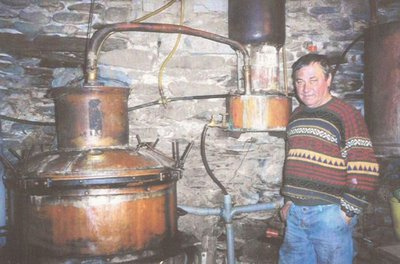
Alambic - © Mémoire vivante  History
HistoryThe still, l'estamaïre and the fountains.
Marker 3
Most families made their own wine. Every harvester had the right to have part of his production distilled at the still, having declared it to the Indirect Taxation Office. The allowance was for a maximum of 20 litres of brandy of 50°.
Unless inhabitants were lucky enough to have a spring on their land, they had to come to the right bank of the Gardon for drinking-water, either to the freshwater fountain or to the fountains on the little square. In 1933, an inhabitant donated her spring to the town council, which installed three standpipes in the village, including two on the left bank. The works were funded by a loan given by another inhabitant.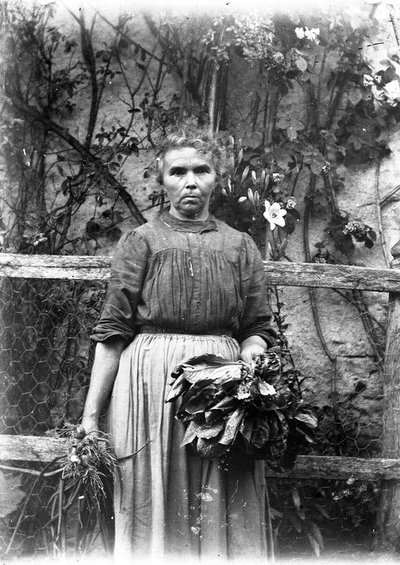
© Mémoire vivante  History
HistoryWomen
Marker 4
While women, undeservedly, did not yet have their civic rights recognised – they did not gain the right to vote until 1944 – they were active. Young women often took positions in bourgeois households so that their families were no longer responsible for their upkeep. There, they learned to cook, sew and run a household. Others worked in the spinning mill. Once married, they often had large families (contraception and abortion being forbidden and punishable by imprisonment), which did not prevent them from helping their husbands on the farm or in the shop. They had to wait until 1980 for the status of co-farmer to be created.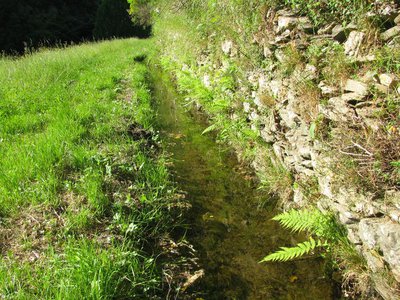
© Mémoire vivante  History
HistoryBancels and water
Marker 5
The fact that the Gardon was so close gave the village many advantages. There was no need for a wash-house; the gardens were irrigated by pumping water from the river or from wells. Parcels further away were irrigated using small channels (béals) that were dug out or built. These drew their water from a brook in which a deviation dam (païsière) had been built. The tiniest patch of land, which is today covered by trees and bushes, was used as a bancel – terraced cropland on the slopes. Shored up by drystone walls, these terraces made it possible to grow on flat land.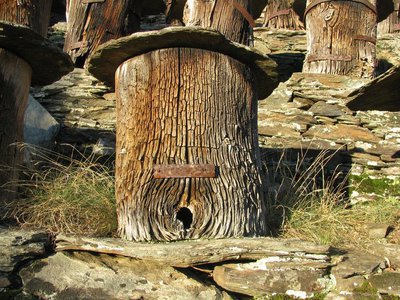
Ruche tronc - © Mémoire vivante  Tradition
TraditionRecipes using chestnuts
Marker 6
Brasucade: fresh chestnuts are scored and roasted over a wood fire in a holed frying pan. You have to shake the pan regularly so they do not burn. Before eating, they were wrapped in newspaper for some time to facilitate the peeling. A child sat on top as if to hatch them, or else they were used for warming feet.
Bajana: After being dried in a clède (chestnut drying building), the chestnuts are put to soak in the evening, then cooked in water for about two hours the following day. They are served as a soup, either plain or diluted with milk or wine.
© Mémoire vivante  History
HistoryProtestant tombs
Marker 7
The Revocation of the Edict of Nantes (1685) was accompanied by discriminatory measures against Protestants (forbidding public office, access to Protestant churches and cemeteries). In response, clandestine cemeteries were created by the Protestants. Burials were carried out at night, often in cellars or in fields. A certain amount of tolerance had become the norm from 1760 onwards, but it was the Edict of Tolerance (1787) which legalised the existence of Protestant burial grounds.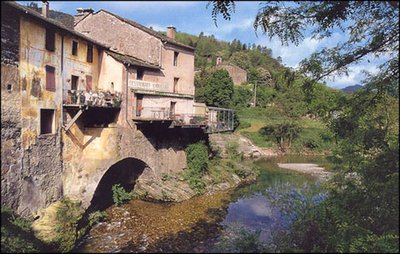
© Mémoire vivante  History
HistoryThe river
Marker 8
Be careful of the Gardon river’s fits of anger during Cevenol episodes (heavy rainstorms). These gardonnades have deepened the riverbed by several metres. They also twice swept away the footbridges that were the only link between the left and right banks until 1970. Three wooden footbridges enabled pedestrians to cross the Gardon: one upstream of the village, near the spinning mill; one in the centre to access the gardens; and one downstream. They were solidly secured only at one end so that the floods would push them to the bank. This was known as when “the plank has turned”.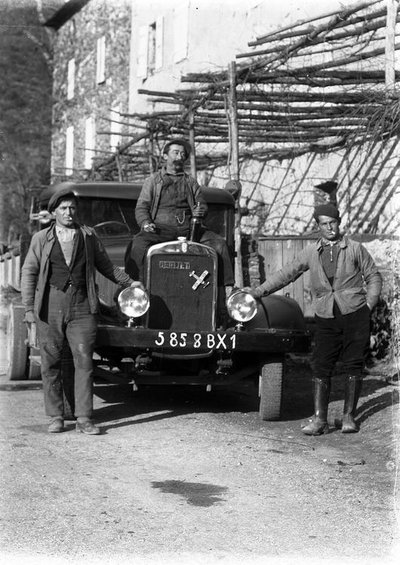
© Mémoire vivante  History
HistoryThe stone-breaker
Marker 9
Travel was mostly on foot, though biking was becoming popular. The biker who returned home without a puncture was lucky – studded shoes and overshoes were always losing their nails. Most roadways were gravelled. The bridges and highways agency, which was in charge of their upkeep, employed young men to get stones out of the river that the stone-breaker would then reduce to more or less small pieces, depending on needs. Municipal paths, which were the responsibility of town or village councils, were maintained by riverside inhabitants, who received a local-tax rebate for their days of service.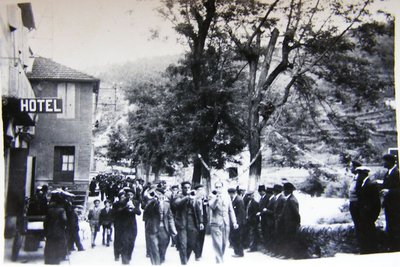
© Mémoire vivante  History
HistoryThe montgolfière
Marker 10
The village fête took place over three days in July: Saturday on the little square, Sunday on the left bank and Monday at the village entrance, so that every café could benefit. It was organised by the local conscripts, men 20 years of age who had been declared fit by the draft board to join a regiment. Musicians – often two or three locals – played at the ball and during the tournée des fougasses (traditional sweet breads sold door to door to finance the fête) all over the municipality. A small montgolfière (hot air balloon) was released to close the fête.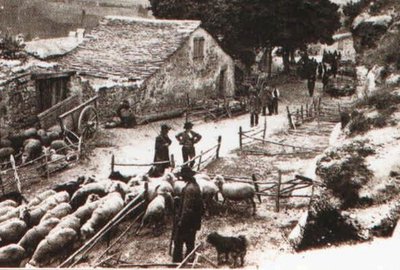
Foire - © Mémoire vivante  History
HistoryCafé Gély and the fairs
Marker 11
There were ten fairs a year, of varying importance. Since the village had no fairgrounds, animals were divided by category: sheep and goats “at the foot of the village”; piglets on the river banks. Farmers made their deals in the bistros. Women often participated in the patche (business negotiations), then went home with the money. Calixte Tinel bought goats from several dealers. At the end of the fair, he offered lollipops to the children who would help him to encaminer (guide) the herd out of the village. The fair stalls and games (Cevenol skittles, for example) stretched along the road and the little square.
© Mémoire vivante  History
HistoryBrandade
Marker 12
Until the late 19th century, food was dried and salted for preservation. Cod is a fish from the northern seas. Fishermen from that region fetched supplies of salt at the saltworks in Aigues-Mortes, where they swapped their fish for salt. The recipe for cod brandade was created around 1766. It consists of shredding the desalted and poached cod, adding olive oil and brandir the mixture. In Provençal, brandir means to stir, hence brandade.
Caïfa par Edith Bouvier - © Mémoire vivante  History
HistoryLe Caïffa
Marker 13
The shop Le Caïffa was owned by Au Planteur de Caïffa, which was initially a coffee company. The manager criss-crossed the countryside with his cart bearing the shop’s name to sell its products.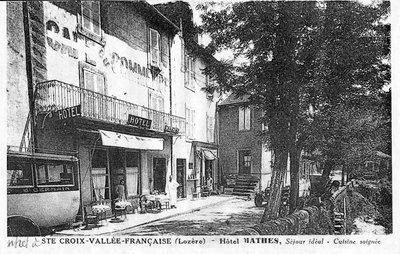
Sainte-Croix - © Mémoire vivante  History
HistoryProfessions of the olden days
Marker 14
As the seasons turned, the village would be visited by the pelharot, who collected rabbit pelts; the cadiéraïre, who made and repaired chairs; and the estamaïre, who melted tin to cover cutlery with. A couple of peddlers with suitcases full of lace, haberdashery items and household linen lodged at the hotel while criss-crossing the surrounding countryside on foot. Another emblematic figure of the day, Dr Atger, visited his distant patients on horseback. To retain the doctor, in 1920 the village council voted to award him an annual allowance of 350 francs.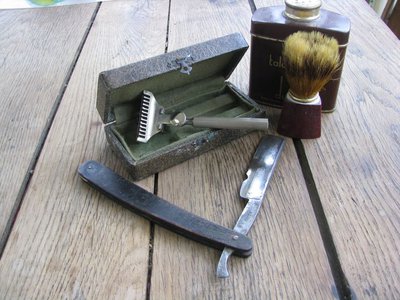
Matériel du barbier - © Mémoire vivante  History
HistoryVersatility
Marker 15
Versatility was commonplace, and if you went to the bistro, it was not necessarily to have a drink but perhaps to have a shave or haircut or to have your bike repaired.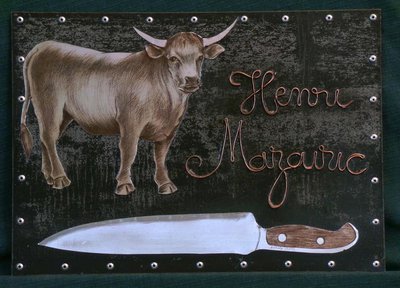
© Mémoire vivante  History
HistoryThe butcher
Marker 16
The local butcher, who was also a wholesaler, slaughtered animals when he had the time. Two itinerant butchers visited the village every fortnight.
© Mémoire vivante  History
HistoryGrapevines
Marker 17
In those days, all terraces were cultivated. Grapevines in parallel rows, which were well maintained using a bigot, covered a large part of them. The bigot, a pickaxe with two flat blades, was the farmers’ favourite tool for working the land. It was regularly repaired, meaning that metal was added by the blacksmith at the forge. Against the walls, trellises and cabayous (espaliers) made use of the tiniest patches of soil. The grapes were harvested and made into wine.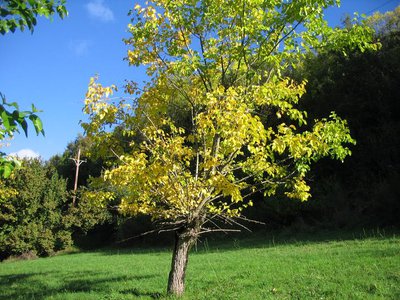
Le mûrier - © Mémoire vivante  Know-how
Know-howFrom the mulberry tree to silk
Marker 19
Every farmhouse had its magnanerie (silkworm farm), often an entire floor, where silkworms were bred. Black or white mulberry trees supplied the leaves which are the silkworm larva's only food until it builds its cocoon. The latter is a single silk thread that encloses the larva during its chrysalis stage. The moth emerges by making a hole in the cocoon to escape. For the thread to be used in a spinning mill, the nymph must be suffocated to prevent it from cutting the thread, so that the thread can be unwound. The work in a spinning mill consists of unwinding the long cocoon threads to turn them into silk skeins.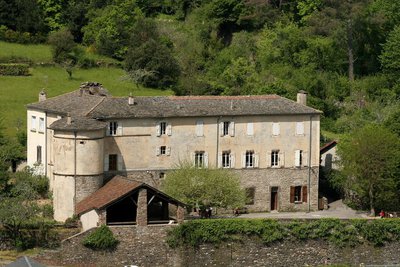
© Mémoire vivante  History
HistoryDemocracy, the school, and the last word
Marker 21
The Château de Sainte-Croix used to be the residence of the Lords of Gabriac. In 1892 it was bought by the village, which turned it into the school and town hall.
Annie tells us: “During breaktime, the girls would clean the windows. We had to make the rags to wipe the blackboards out of the teacher’s old socks.”
Abbé Chauvet - © Mémoire vivante  History
HistoryDenominations and frênette
Marker 20
This valley, which has inherited a past anchored in the Protestant faith, has always had a Catholic community, concentrated around the parishes of Sainte-Croix and Saint-Etienne-Vallée-Française. In those days, the two religions lived together on good terms. However, cross-denominational marriages, which were rare, required conversion to Catholicism.
Rémi tells us: “The abbot gave us a drink in a glass. He said, ‘That’s frênette.’”. Frênette is a fermented drink made from ash leaves. Fermentation occurs due to the honeydew left on the leaves by aphids.
Forecast
Altimetric profile
Recommandations
To hear the oral history accounts in their entirety: either directly via a smartphone (QR code on the panels) or on audioguides available at the tourist office. Excerpts of the accounts are broadcast directly on the platform Destination Cévennes.
Information desks
Tourism office Des Cévennes au mont-Lozère, Sainte-Croix-Vallée-Française
Mairie, 48110 Sainte-Croix-Vallée-Française
This office is part of the National Park's associated tourist-information network, whose mission is to provide information on, and raise awareness of, the sites and events as well as the rules that must be observed in the National Park's central zone. :
Open year-round
Access and parking
D983 from Barre-des-Cévennes or Saint-Jean-du Gard to Sainte-Croix-Vallée-Française.
Parking :
Car park at the mairie (town hall)
Calculateur d'itinéraire Lio
Utilisez le calculateur liO pour organiser votre trajet en région Occitanie.
Autres régions
Calculez votre itinéraire en Auvergne Rhône Alpes sur Oùra
Biodiversité autour de l'itinéraire
Source

Parc national des Cévenneshttp://www.cevennes-parcnational.fr/
Report a problem or an error
If you have found an error on this page or if you have noticed any problems during your hike, please report them to us here:

